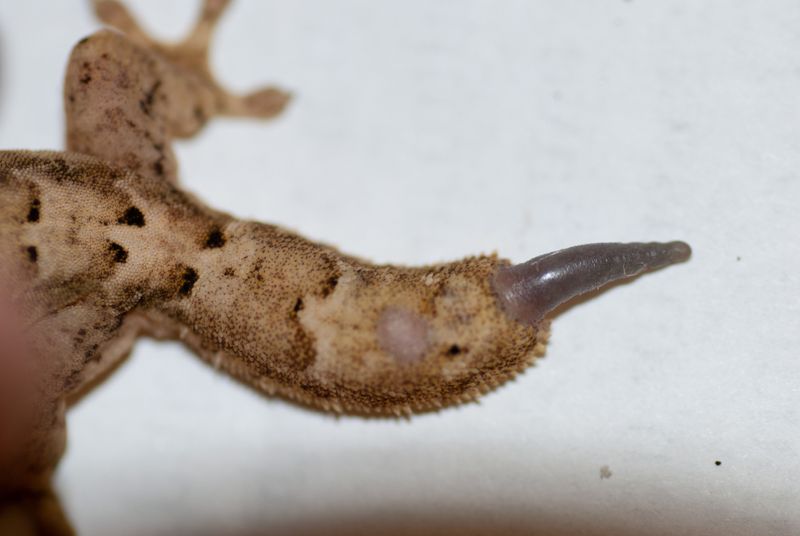ABOVE: Thomas Lozito poses with Donald, one of his mourning geckos (Lepidodactylus lugubris). Thomas Lozito, Keck School of Medicine
Thomas Lozito began investigating amphibians and reptiles when he was just five years old. He says he was fascinated by the rescued turtles his father, a real estate agent, would bring him from work in New Jersey, and by the time Lozito was in kindergarten, he had even joined the local herpetological society. Once a month, he’d find himself “in the back of a public library with a bunch of middle-aged men talking about turtle breeding,” he laughs. Lozito remained a member until leaving for college, and has kept various reptiles, especially lizards, ever since.
After completing his undergraduate degree in biomedical engineering at Johns Hopkins University, Lozito enrolled at the University of Cambridge, where he studied stem cell biology. During his doctoral work researching the environmental signals that regulate adult stem cell differentiation and homeostasis, he began working with Rocky Tuan, a bioengineer at the National Institutes of Health (NIH), as part of a joint program between the two institutions. Lozito earned his PhD in 2009 and moved to Tuan’s new lab at the University of Pittsburgh for a postdoc. Together, the two did seminal work uncovering how endothelial cells talk to stem cells using cell-derived vesicles.
“All along, he [was] a lizard lover,” Tuan says of Lozito, who introduced Tuan to his many pets, which included mourning geckos (Lepidodactylus lugubris), a species that would later prove critical to Lozito’s research. Through their discussions, Tuan realized that herpetology was highly relevant to his research interests in stem cells, musculoskeletal biomedicine, and regenerative medicine. Understanding how lizards regrow their cartilaginous tails, the two speculated, could one day lead to treatments for human conditions such as osteoarthritis. In 2015, Lozito was promoted to assistant professor at the University of Pittsburgh, and the pair turned their sights toward the secrets of limb regeneration in lizards.

With so little known, they had to start by answering basic questions, such as why regenerated lizard tails remain almost entirely cartilaginous, with only the most terminal remaining vertebra generating new bone following amputation. In the course of tail regeneration, a cartilaginous tube encapsulates the regenerated spinal nerves and is covered by muscle and skin. Lozito and Tuan found that differentiation at both ends of this tube is partly regulated by variability in the signaling protein Indian hedgehog (Ihh), a protein homolog involved in the Hedgehog signaling pathway that promotes the growth of bone and cartilage. Lozito also studied which cells contribute to the regenerated appendage, finding that existing cartilage cells in the mourning gecko’s tail contribute not just to cartilage repair, but also to muscle regeneration, and muscle cells similarly contribute to the regeneration of both tissues.
In 2019, Lozito joined the faculty of the University of Southern California (USC) and started his own lab. Today, he and his team are investigating the imperfections of lizard tail regeneration, specifically the fact that regrown tails lack dorsal-ventral patterning. But after taking embryonic neural stem cells from a mourning gecko, using CRISPR-Cas9 to render them unresponsive to Hedgehog signaling, and reimplanting them into an adult with an amputated tail, Lozito was able to induce the patterning in the regenerated appendage.
See “Engineered Stem Cells Grant Geckos “Perfectly” Regenerated Tails”
If the goal is human regeneration, Lozito’s success with reptiles may sound like incremental progress, he says, but he adds that his work has been defined by constant small steps interspersed with the occasional leap forward. “Our five- to ten-year goal is to make a mouse regenerate its tail like a lizard,” Lozito says. “So every time we meet in the lab, we keep that goal in the back of our minds.”
Studying lizards to one day treat people is certainly a novel approach, says Lozito’s colleague Denis Evseenko, the director of skeletal regeneration at USC. The two men are working together on a novel drug to regenerate human joint and skin tissues that will soon enter clinical trials. During their early research, which has not yet been published, they tested it on non-regenerating lizard species, and to Evseenko’s surprise, it worked, he says. When they applied the compound to the tail stumps of these non-regenerating lizards, the tails started growing back. Evseenko calls the findings “remarkable,” adding that working with Lozito has made him “a little bit more open and enthusiastic to this [lizard] model, because it helps us know what questions to ask.”

Membership Open House!
Enjoy OPEN access to Premium Content for a limited timeInterested in exclusive access to more premium content?




